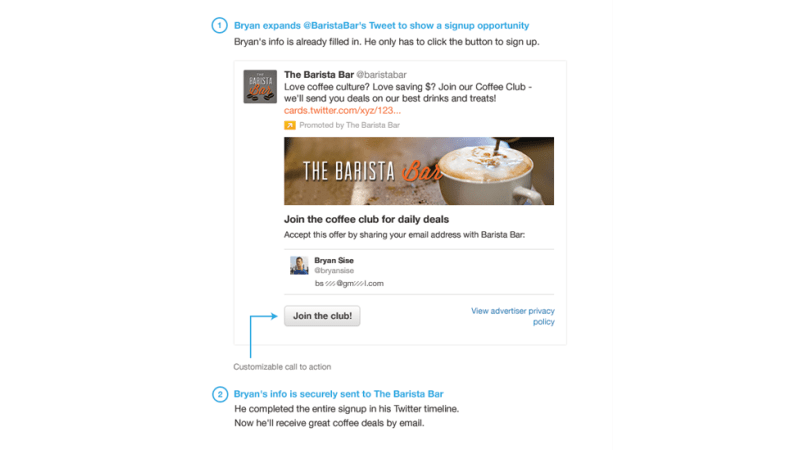Twitter’s recent announcement of its Lead Generation Card is big news but perhaps more so for Twitter than the Lead Generation Industry as a whole.
If you broadly divide online ad spend into brand awareness and performance then up until now Twitter has mainly been concentrating on the brand side of equation. Its current advertising solutions mainly allow brands to increase their presence on Twitter increasing their follower numbers and retweet counts under the banner of “engagement”. This has already generated hundreds of millions of dollars for Twitter and probably quite a bit for many its advertisers. While it seems this will continue to be a core part of their revenue strategy for some time, as they head towards an IPO it looks like there will be an increasing focus on performance and trying to eat some of Google’s lunch.
The Lead Generation Card is an interesting move into the performance market but it seems – at least for the first iteration – the pros and cons are finally balanced.
Lead Generation on Mobile
Twitter’s president of global revenue, Adam Bain is certainly right that the product addresses a fundamental issue around generating leads through mobile devices. There are very few well executed mobile lead generation campaigns and capturing leads within Twitter where a huge chunk of the traffic is mobile is a step in the right direction but it is also severely limited.
Over recent years, the lead generation industry has moved away in large part from a simple registration model to a more premium customer journey where consumers have to submit multiple fields of information including phone number, postal address and a variety of other information about their circumstances. The current Twitter execution only allows for a consumers full name and email address.
This information might not be worth much to an advertiser if they don’t already have a sophisticated email marketing programme set up that can monetise all those consumers that submit their email details. From my experience, not many brands do this, let alone do it well. In fact, a poor follow up strategy can actually do more harm than good. If you tell a consumer they are signing up to something, you then have an obligation to deliver. If you sign people up under the pretext of sending them great offers then you need to actually send them and do so in a way that is efficient and allows you to track the outcomes.
There is an obvious appeal to a certain group of advertisers that want to generate email sign-ups for their newsletter databases such as discount and voucher code sites but beyond this it is hard to see how large the appetite will be from advertisers.
Question Mark Over Payment
There is also the question of how advertisers will pay for this activity. Lead generation in its purest form (as defined by the IAB) is predicated on the advertiser paying on a cost per lead (CPL) for every enquiry. It is unclear whether this is how Twitter will charge now or whether they plan to in the future.
While there are certainly limitations and questions to be answered, it is also important to point out some of the plus points of the new feature. As well as creating an improved user experience for lead generation on mobile there is also the advantage that as the email addresses are pulled directly from a user’s profile there is very little room for inaccurate data being passed to the advertiser (unless of course accounts have been set up with fake info). This has been a scourge of lead generation for many years so any way to improve the accuracy of data should be welcomed.
In the long term, where this feature could add the most value is to the SME end of the market. If smaller advertisers are able to capture leads for their products and services they will be far better placed to generate material ROI from the data collected.
As with everything new, it will take time and experimentation by brands to find out the true value of this new proposition. This is only the first iteration of the feature so we can expect a lot more developments and improvement as it is rolled out globally and users start giving more feedback. In the meantime, expect to see every man and his dog trying to get your email address on Twitter!

